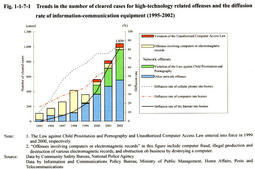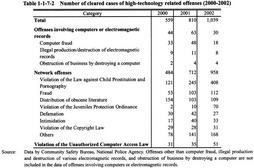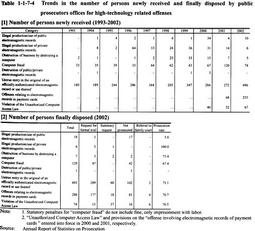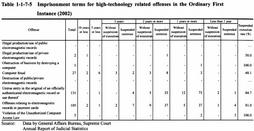| Previous Next Index Image Index Year Selection | |
|
|
1 Overview of high-technology related offenses High-technology related offenses are those offenses that are committed by misusing computer and telecommunication technology. These offenses are roughly categorized into the following 3 groups: (a) computer offenses in the narrow sense; (b) network offenses ; and (c) unauthorized computer accessing acts, etc.
Computer offenses in the narrow sense refer to offenses involving computers or electromagnetic records, and include computer fraud, obstruction of business by destroying a computer, etc., and illegal production, use, and destruction of various electromagnetic records. Network offenses refer to offenses committed by using a computer network, and include various types of offenses such as fraud, sales of illegal goods, and the sales/distribution of child pornography, which are committed by using the Internet. Under the Unauthorized Computer Access Law that entered into force in February 2000, such unauthorized computer accessing acts shall be punished as acts of using ID numbers or passwords of other persons via the Network without permission or giving illegal information or commands to the other party's computer system while taking advantage of defects in the system, thereby making specific limited-access computers accessible. (1) Trends in clearance Fig. 1-1-7-1 shows the trends in the number of cleared cases for high-technology related offenses and the diffusion rate of computers, the Internet, and cellular phones in homes over the last 8 years. The number of cleared cases of network offenses increased rapidly along with the growing diffusion rate of the Internet.
Fig. 1-1-7-1 Trends in the number of cleared cases for high-technology related offenses and the diffusion rate of information-communication equipment (1995-2002) Table 1-1-7-2 shows the number of cleared cases for high-technology related offenses over the last 3 years, by type of offense. In the category of network offenses, the number for violation of the Law against Child Prostitution and Pornography increased significantly to 408 in 2002, accounting for more than 40% of the total number of cleared cases of network offenses. Computer fraud with the use of a network accounted for the second largest share with 112 cases, 60 cases of which involved Internet auctions.The cleared cases for "others," 168 cases, include various offenses such as Stimulant Drug Control Law violations and other drug offenses, Firearms and Swords Control Law violations, Anti-Prostitution Law violations, and Trademark Law violations (Source: Data by Community Safety Bureau, National Police Agency). Table 1-1-7-3 shows the number of handguns seized by the police over the last 5 years, which were recognized to have been traded via the Internet. It indicates that computer networks are misused not only for sexual and property offenses but also for other offenses that would affect public security. The number of cleared cases of violations of the Unauthorized Computer Access Law has been increased every year, though slightly, from 31 to 35, and 51, since the law entered into force in 2000. Unauthorized computer accessing acts impede the sound development of the advanced information and communication society, and therefore attention should be paid to this type of offense. Table 1-1-7-2 Number of cleared cases of high-technology related offenses (2000-2002) Table 1-1-7-3 Number of seized handguns traded via the Internet (1998-2002) (2) Disposition by public prosecutors offices and by courts Table 1-1-7-4[1] shows the trends in the numbers of persons newly received by public prosecutors offices over the last 10 years for high-technology related offenses, by type of offense. Table 1-1-7-4[2] shows the number of persons finally disposed by the same offices in 2002 for these offenses. For those offenses for which the number of persons disposed were large (untrue entry in the original of an officially authenticated electromagnetic record or use thereof, offenses involving electromagnetic records in payment cards, computer fraud, and violation of the Unauthorized Computer Access Law), prosecution rates were around 70%, higher than the overall prosecution rate of general penal code offenses (55.4%).
Table 1-1-7-4 Trends in the number of persons newly received and finally disposed by public prosecutors offices for high-technology related offenses Table 1-1-7-5 shows the term of imprisonment with labor sentenced by the ordinary first instance for high-technology related offenses in 2002.Table 1-1-7-5 Imprisonment terms for high-technology related offenses in the Ordinary First Instance (2002) |




